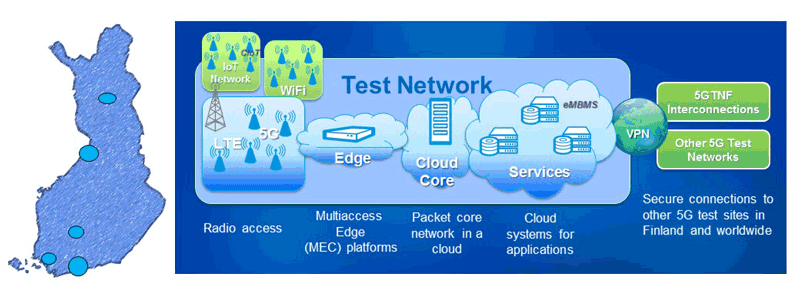by Olli Apilo, Mikko Uitto and Jukka Mäkelä. (VTT)
Controlled test environments enable testing and development of next generation use cases. VTT Technical Research Centre of Finland Ltd is testing 5G use cases covering several vertical industry domains for improved living quality, including solutions for sports wearables and media broadcasting.
One of the goals of 5G is to fulfil the needs of future applications that require even higher data rates or low latency wireless connectivity. However, with the current LTE-A Pro it is already possible to create similar network conditions to the impending 5G technology by allocating most of the network resources to a single dedicated test. VTT has piloted and tested several use cases in different vertical industry domains including smart grids, connected and autonomous vehicle communications, mobile TV, and IoT applications such as wearables. Before widespread deployment of the emerging applications, it is important to test their performance in real live networks without disturbance to existing services.
5G Test Network Finland (5GTNF) is a joint effort between Finnish academic and industrial partners. It combines several local test network environments such as 5GTN equipped with latest wireless and wired technologies, see Figure 1. Live parts of 5GTN use the latest LTE-A Pro technologies with operator-grade evolved packet core. 5G links can be tested in the private laboratories with non-commercial prototypes. In 2019, 5GTN will be upgraded with available commercial 5G new radio (NR) base stations and a 5G service core.

Figure 1: Locations and typical setup of different 5G test sites in Finland.
Test cases “IoT for sports wearables” and “Broadcast for efficient media delivery”, described below, are examples of 5G use cases, which were conducted in a 5GTN environment located in Oulu, Finland. The complete 5G test system – from infrastructure to applications and services – allows unique testing possibilities from prototype devices to complete solutions in a controlled environment. The use cases and associated test scenarios from our industry partners and research projects guide the evolution of 5GTN.
Testing Cellular IoT for Sports Wearables
To meet the growing demand for widespread and reliable IoT connectivity, 3GPP developed narrowband IoT (NB-IoT) and LTE for machine-type communications (LTE-M) that can be deployed to existing LTE network infrastructure with software updates. These cellular IoT (CIoT) technologies support extended coverage, low device cost, and minimised power consumption [1]. Sports wearables are predicted to be one of the new application domains of CIoT. Sports wearables measure various parameters, such as heart rate and location, during an exercise. Currently, the measured data is uploaded after exercise using USB or a short-range wireless link. CIoT enables bi-directional, long-range and real-time connectivity during exercise. This opens up new service possibilities for device users and other interest groups, such as coaches, personal trainers, and sport fans.
The feasibility of CIoT for sport applications was evaluated by field measurements with CIoT evaluation boards connected to LTE-A Pro base stations and core network. Throughput, latency, CIoT modem power consumption, mobility support, and coverage were measured during extensive testing. Both NB-IoT and LTE-M were able to support the transfer of periodic heart rate and location updates as well as the reception of text messages in normal conditions. The CIoT coverage enhancements were not suitable for sport application traffic as the delays become very large due to repetitive transmissions. Although NB-IoT is not primarily designed for wearables, it can also support the basic sport application traffic. The higher data rates and better mobility support of LTE-M enable more advanced use scenarios, such as voice calls, at the price of higher power consumption.
Broadcasting for Efficient Media Delivery
Current mobile media distribution suffers not only from waste of network resources and spectrum, but also due to its inability to adjust peak times for popular content. 5G enables high throughput data transmission, but a large number of simultaneous media users in the same area can result in a lower quality experience for end users. Therefore, 5GTN acquired evolved multimedia broadcast multicast service (eMBMS) from Expway to distribute popular content more efficiently with high quality whilst saving core transmission capacity and spectrum. eMBMS has already been introduced in 4G LTE [2], but it still lacks a business model, especially for operators. However, the increasing number of mobile video users should give the needed boost to eMBMS usage in Finland during the era of 5G. One of the use cases “Broadband and media everywhere” by Ericsson emphasises the importance of efficient video streaming techniques in 5G.
eMBMS service was in the air for the first time in Finland, distributing live content from the Finnish broadcasting company, Yle. The successful eMBMS demonstrations and an extensive set of lab experiments revealed that multicast/broadcast based techniques outperform the traditional unicasting, especially in terms of network bandwidth load and spectrum usage, thereby freeing up precious network capacity for other tasks. Where unicast streaming requires as many streams as there are users, eMBMS requires only a single stream delivered to everyone. Thus, this is also a step in the right direction towards green networking.
Conclusions
The vertical use cases realised and tested in the 5GTN environment have shown the emerging needs of 5G actualisation in real life scenarios where high data rates, transmission efficiency, energy efficiency and reliability are needed. The demonstrations and results carried out during the project provide important information regarding future developments in CIoT and eMBMS deployment and resolve possible bottlenecks in their utilisation. These form an excellent basis for the evolution of 5GTNF and trigger for future developments where more adaptation against fluctuations and dynamic intelligence is needed from the network.
References:
[1] O. Liberg, et al.: “Cellular Internet of Things: Technologies, Standards, and Performance”, London, UK: Academic Press, 2018.
[2] D. Lecompte and F. Gabin: “Evolved multimedia broadcast/multicast service (eMBMS) in LTE-advanced: overview and Rel-11 enhancements”, IEEE Communications Mag., vol. 50, no. 11, pp. 68-74. Nov. 2012.
Please contact:
Jukka Mäkelä
VTT Technical Research Centre of Finland











